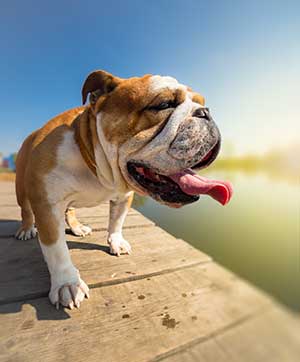What Is Heat Stroke?
Heat stroke can happen at any time of the year, but is most commonly problematic in the summer months. It can occur suddenly and without warning.
Heat Stroke is defined as an increase in core body temperature caused by environmental conditions. The normal body temperature for your dog should be 99-102.5 degrees Fahrenheit. If your pet’s temperature is above 105, immediate veterinary care is required. Heat stroke is an extremely serious condition that can be fatal.

Why Does Heat Stroke Occur In My Pet?
Humans have the ability to regulate their body temperature through the numerous sweat glands on our bodies. Dogs and cats however, only have a few sweat glands located in their paw pads and around their noses. Dogs and cats are not able to sweat so they regulate their body temperature by panting. When panting is not enough to cool their body, and their temperature continues to rise, this can lead to heat stroke.
What Are The Signs And Symptoms Of Heat Stroke?
There are a number of signs and symptoms to be on the lookout for. It is important to remember that these symptoms can progress quickly and become more severe leading to death.
Early signs of Heat stroke include:
As the condition worsens, signs and symptoms progress to include:
Heat stroke is not as common in cats, but they can also display the following signs:
What should I do if I think my pet has a heat stroke?
Heat stroke is a serious condition and symptoms should always be treated as an emergency. The quicker you are able to get to your veterinarian the better the outcome for your pet. While making your way to the vet you can put the air conditioner on full and place a wet towel, cool NOT cold, over your pet for the ride. The towel does not need to be tightly wrapped around the pet, but rather just draped to allow the moisture to relieve the heat from the pet's skin. If your dog is able to drink, allow them to have as much water as they want without forcing them to drink.
Prevention Tips
Heat Stroke is completely preventable and knowledge of the signs and symptoms is key. Watson’s tips are:
The Best Ways to Beat the Heat
If you suspect your pet has Heat Stroke, contact us at Watson’s Friends Animal Hospital, 941-297-0880, immediately. If we are closed, call your nearest Animal Emergency Service Hospital.
Bradenton Veterinary Emergency
2910 Manatee Avenue W
Bradenton, FL 34205
941-748-0202
Lakewood Ranch Urgent Vets
9620 S.R. 64
East Bradenton, FL 34212
941-277-9700
Phone: 941-297-0880